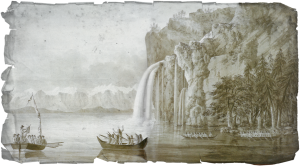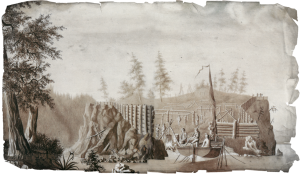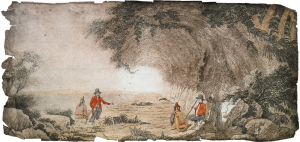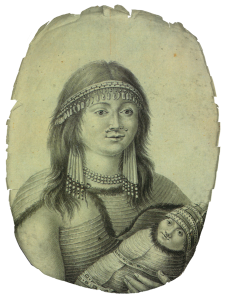1493
The Spanish domain over the west coast of America dates back to 1493. Through a papal bull and under the Treaty of Tordesillas (1494), Spain had exclusive rights over American territories not counting what is now Brazil.
1513
The first expedition to reach the Pacific coast was that of the Spanish Vasco Núñez de Balboa in 1513, where he took control of the areas and consolidated them Spanish territory. For centuries, the Spanish maintained their dominance in what is now known as South and Central America. Expeditions to the north happened 250 years later.

1774
In 1774, the Viceroy of New Spain, Antonio María Bucareli y Ursúa, sent a crew of Spaniards of Mexican origin, under the command of Juan Pérez Hernández, to explore and establish relations with the natives, in order to know and explore the territories that would possibly be under the control of Russian traders. In July of the same year, he arrived on Lángara Island, where they made contact with the Haida natives. However, the crew did not land due to the lack of supplies and health problems of the crew.

1775
In 1775, Viceroy Bucareli decided to form the second expedition towards 60 degrees north latitude. A group of qualified officers arrived at the port of San Blas, the best Spanish naval academy, aiming to help carry out this expedition. Bruno de Heceta would be the lieutenant in command of carrying out this expedition, with Juan Pérez Hernández as second in command.
1775
In July, both ships arrived on the coast of present-day Washington state. When this group came ashore, 300 Quinault warriors massacred the seven explorers and then tried to board the Sonora. This action was quickly stopped when Bodega ordered fire by means of defense and to return the Sonora to meet with the Santiago out to sea and continue its course north.

1775
The Sonora reached 59 degrees north latitude, until it decided to return south due to poor health conditions of its commanders and crew members. In October 1775, both ships met again in Monterey Bay, where they stayed until they recovered from the diseases of the trips and together sailed back to San Blas to inform the Spanish Crown about the discoveries.
1779
In 1779 the third expedition was carried out through the northern territories. Two ships, La Favorita, under the command of Ignacio de Arteaga, and La Princesa, commanded by Bodega and Quadra, departed with the objectives of evaluating Russian intervention in Alaska, searching for a Northwest passage and possibly capturing James Cook, that was known to be in Spanish waters.
1779
In June 1779 the same year, Spain entered the American Revolutionary War as an ally of France, thus giving rise to the Anglo-Spanish War that continued until 1783 when the Treaty of Paris was signed. After several months of sailing, both ships decided to return due to food shortages and the constant presence of illnesses of their crewmembers. The exploration trips carried out by Arteaga and Bodega and Quadra were made public, so much so, that they were published in London under Mourelle’s diary.
1788
In 1788, another expedition was carried out whose purpose was to investigate the Russian presence on the west coast. Esteban José Martínez and Gonzalo López de Haro departed for Prince William Sound, and in June of the same year Haro arrived on the Kodiak Island, where, with the help of the natives, he learned about the Russian presence in the area. At the end of June, Narváez established contact with Russian citizens at Three Saints Bay post, thus becoming the first Spanish to contact the Russians in the territory of Alaska.

1789
After the trip to Alaska in 1788, Martinez and Haro were ordered to take control of the Nootka Sound before the Russians and British did so. These events triggered the Nootka Crisis between Britain and Spain, where fortunately a war for the rights of the territory could be prevented.
1790
During the Agreements of the Nootka Crisis, the Viceroy of New Spain decided to establish a base at Nootka Sound. Francisco de Eliza, Manuel Quimper, and Salvador Fidalgo set off for Nootka to establish the settlement of Santa Cruz de Nootka with soldiers of the First Free Company. After establishing these posts, Eliza commanded Fidalgo and Quimper on different exploration trips.

1790
In 1790, Salvador Fidalgo left for Alaska in order to perform acts of sovereignty in different areas of the Pacific Coast. Fidalgo entered Cook Inlet, and on his way found different Russian checkpoints, at the mouth of the Kenai River, on Kodiak Island and what is now Nanwalek. Fidalgo continued towards the Kenai Peninsula where the Spanish claim continued in the explored areas.

1790
On the other hand, Manuel Quimper sailed through the Strait of Juan de Fuca. On his way to the eastern end of the strait, he discovered the islands of San Juan and a number of narrow inlets, but did not have enough time to do a detailed study of the area and returned to Nootka, where due to the strong opposing winds , had to deviate and head back to San Blas.
1791
In 1791, Francisco de Eliza departed for the Strait of Juan de Fuca to continue the exploration. In this exploration, he discovered the Strait of Georgia under the command of Narváez. The ship quickly returned to Monterrey to inform Alejandro Malaspina about the discovery of that strait, which triggered the exploration of Galiano and Valdés in 1792.
1791
The King of Spain commissioned a scientific expedition with the aim of investigating a possible passage from the Northeast, searching for gold, precious stones and possibly reporting on Russian and British settlements in the northwestern area. In 1791, Malaspina and Bustamante arrived in Yakutat Bay, where they contacted the natives of the Tlingit tribe, where they studied their social customs, language, economics, funeral practices and methods of warfare.

1792
In 1792, Galiano and Valdez y Flores sailed to Nootka Sound, circumnavigating Vancouver Island. This trip was published and widely promoted in Spain, which overshadowed Malaspina’s trip.
1792
Caamaño carried out a number of expeditions south of Nootka Sound on present-day Vancouver Island, detailing areas that had been ignored by former European explorers. None of his reports were published until much later, however, during his expeditions Caamaño met George Vancouver, who took copies of his maps for his explorations, and still incorporated the names designated by Caamaño.
1819
In 1819, with the Adams-Onís Treaty, Spain withdrew from the North Pacific and transferred its claims to the United States.
